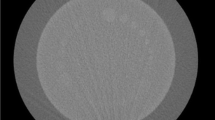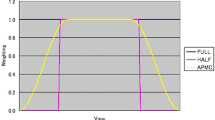Abstract
Purpose
The aim of this study is to assess the value of adaptive statistical iterative reconstruction (ASIR) and model-based iterative reconstruction (MBIR) for reduction of metal artifacts due to dental hardware in carotid CT angiography (CTA).
Methods
Thirty-seven patients with dental hardware who underwent carotid CTA were included. CTA was performed with a GE Discovery CT750 HD scanner and reconstructed with filtered back projection (FBP), ASIR, and MBIR. We measured the standard deviation at the cervical segment of the internal carotid artery that was affected most by dental metal artifacts (SD1) and the standard deviation at the common carotid artery that was not affected by the artifact (SD2). We calculated the artifact index (AI) as follows: AI = [(SD1)2 − (SD2)2]1/2 and compared each AI for FBP, ASIR, and MBIR. Visual assessment of the internal carotid artery was also performed by two neuroradiologists using a five-point scale for each axial and reconstructed sagittal image. The inter-observer agreement was analyzed using weighted kappa analysis.
Results
MBIR significantly improved AI compared with FBP and ASIR (p < 0.001, each). We found no significant difference in AI between FBP and ASIR (p = 0.502). The visual score of MBIR was significantly better than those of FBP and ASIR (p < 0.001, each), whereas the scores of ASIR were the same as those of FBP. Kappa values indicated good inter-observer agreements in all reconstructed images (0.747–0.778).
Conclusions
MBIR resulted in a significant reduction in artifact from dental hardware in carotid CTA.



Similar content being viewed by others
References
Petty GW, Brown RD Jr, Whisnant JP et al (1999) Ischemic stroke subtypes: a population-based study of incidence and risk factors. Stroke 30:2513–2516
The European Carotid Surgery Trialists Collaborative Group (1995) Risk of stroke in the distribution of an asymptomatic carotid artery. Lancet 345:209–212
North American Symptomatic Carotid Endarterectomy Trial Collaborators (1991) Beneficial effect of carotid endarterectomy in symptomatic patients with high-grade carotid stenosis. N Engl J Med 325:445–453
Wyers MC, Powell RJ, Fillinger MF et al (2009) The value of 3D-CT angiographic assessment prior to carotid stenting. J Vasc Surg 49:614–622
Yoo GH, Hocwald E, Korkmaz H et al (2000) Assessment of carotid artery invasion in patients with head and neck cancer. Laryngoscope 110:386–390
Batnitzky S, Price HI, Holden RW et al (1983) Cervical internal carotid artery injuries due to blunt trauma. AJNR Am J Neuroradiol 4:292–295
Borisch I, Boehme T, Butz B et al (2007) Screening for carotid injury in trauma patients: image quality of 16-detector-row computed tomography angiography. Acta Radiol 48:798–805
Kaufmann TJ, Huston J 3rd, Mandrekar JN et al (2007) Complications of diagnostic cerebral angiography: evaluation in 19,826 consecutive patients. Radiology 243:812–819
Taoka T (2010) Imaging and tissue characterization of atherosclerotic carotid plaque using MR imaging. In: Takahashi S (ed) Neurovascular Imaging. Springer-Verlag, London, pp 319–343
Kim JJ, Dillon WP, Glastonbury CM et al (2010) Sixty-four-section multidetector CT angiography of carotid arteries: a systematic analysis of image quality and artifacts. AJNR Am J Neuroradiol 31:91–99
Scheffel H, Stolzmann P, Schlett CL et al (2012) Coronary artery plaques: cardiac CT with model-based and adaptive-statistical iterative reconstruction technique. Eur J Radiol 81:e363–e369
Machida H, Takeuchi H, Tanaka I et al (2013) Improved delineation of arteries in the posterior fossa of the brain by model-based iterative reconstruction in volume rendered 3D CT angiography. AJNR Am J Neuroradiol 34:971–975
Lell MM, Wildberger JE, Alkadhi H et al (2015) Evolution in computed tomography: the battle for speed and dose. Investig Radiol 50:629–644
Kuya K, Shinohara Y, Sakamoto M et al (2014) CT angiography after carotid artery stenting: assessment of the utility of adaptive statistical iterative reconstruction and model-based iterative reconstruction. Neuroradiology 56:947–953
Yang Q, Peng S, Wu J et al (2015) Spectral CT with monochromatic imaging and metal artifacts reduction software for artifacts reduction of 125I radioactive seeds in liver brachytherapy. Jpn J Radiol 33:694–705
Tukey JW (1949) Comparing individual means in the analysis of variance. Biometrics 5:99–114
Naka Y, Sakamoto K, Minamoto T et al (2008) Clinical evaluation of a newly developed method for avoiding artifacts caused by dental fillings on X-ray CT. Radiol Phys Technol 1:115–122
Lee YH, Park KK, Song HT et al (2012) Metal artefact reduction in gemstone spectral imaging dual-energy CT with and without metal artefact reduction software. Eur Radiol 22:1331–1340
Brook OR, Gourtsoyianni S, Brook A et al (2012) Spectral CT with metal artifacts reduction software for improvement of tumor visibility in the vicinity of gold fiducial markers. Radiology 263:696–705
Shinohara Y, Sakamoto M, Iwata N et al (2014) Usefulness of monochromatic imaging with metal artifact reduction software for computed tomography angiography after intracranial aneurysm coil embolization. Acta Radiol 55:1015–1023
Huang JY, Kerns JR, Nute JL et al (2015) An evaluation of three commercially available metal artifact reduction methods for CT imaging. Phys Med Biol 60:1047–1067
Hirata K, Utsunomiya D, Oda S et al (2015) Added value of a single-energy projection-based metal-artifact reduction algorithm for the computed tomography evaluation of oral cavity cancers. Jpn J Radiol 33:650–656
Kidoh M, Utsunomiya D, Ikeda O et al (2016) Reduction of metallic coil artefacts in computed tomography body imaging: effects of a new single-energy metal artefact reduction algorithm. Eur Radiol 26:1378–1386
Morsbach F, Wurnig M, Kunz DM et al (2013) Metal artefact reduction from dental hardware in carotid CT angiography using iterative reconstructions. Eur Radiol 23:2687–2694
De Crop A, Casselman J, Van Hoof T et al (2015) Analysis of metal artifact reduction tools for dental hardware in CT scans of the oral cavity: kVp, iterative reconstruction, dual-energy CT, metal artifact reduction software: does it make a difference? Neuroradiology 57:841–849
Thibault JB, Sauer KD, Bouman CA et al (2007) A three dimensional statistical approach to improved image quality for multislice helical CT. Med Phys 34:4526–4544
Nishida J, Kitagawa K, Nagata M et al (2014) Model-based iterative reconstruction for multidetector row CT assessment of the Adamkiewicz artery. Radiology 270:282–291
Pickhardt PJ, Lubner MG, Kim DH et al (2012) Abdominal CT with model-based iterative reconstruction (MBIR): initial results of a prospective trial comparing ultralow-dose with standard-dose imaging. AJR Am J Roentgenol 199:1266–1274
Fuchs TA, Stehli J, Bull S et al (2014) Coronary computed tomography angiography with model-based iterative reconstruction using a radiation exposure similar to chest X-ray examination. Eur Heart J 35:1131–1136
Acknowledgements
The authors thank Naoki Iwata and Junichi Kishimoto of the Division of Clinical Radiology, Tottori University Hospital, who provided support with regard to the technical terms related to the scanning system.
Author information
Authors and Affiliations
Corresponding author
Ethics declarations
Funding
No funding was received for this study.
Conflict of interest
The authors declare that they have no conflict of interest.
Ethical approval
All procedures performed in studies involving human participants were in accordance with the ethical standards of the institutional research committee and with the 1964 Helsinki Declaration and its later amendments. For this type of study, formal consent is not required.
Informed consent
Informed consent was obtained from all individual participants included in the study.
Rights and permissions
About this article
Cite this article
Kuya, K., Shinohara, Y., Kato, A. et al. Reduction of metal artifacts due to dental hardware in computed tomography angiography: assessment of the utility of model-based iterative reconstruction. Neuroradiology 59, 231–235 (2017). https://doi.org/10.1007/s00234-017-1811-5
Received:
Accepted:
Published:
Issue Date:
DOI: https://doi.org/10.1007/s00234-017-1811-5




